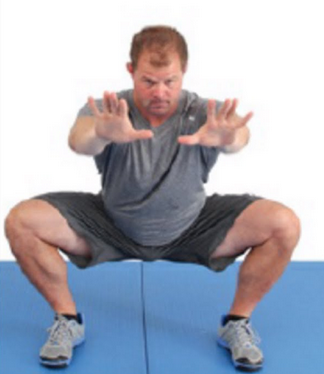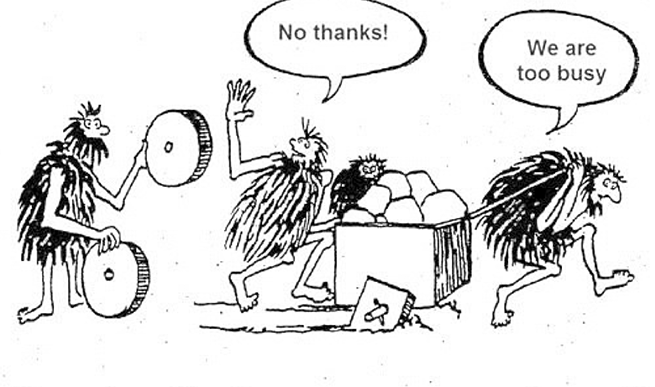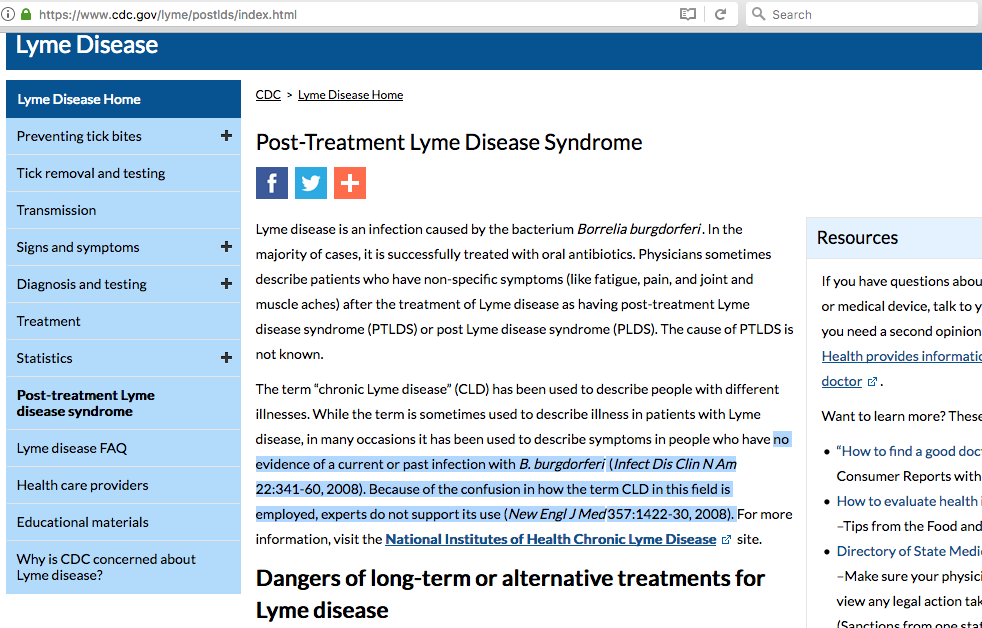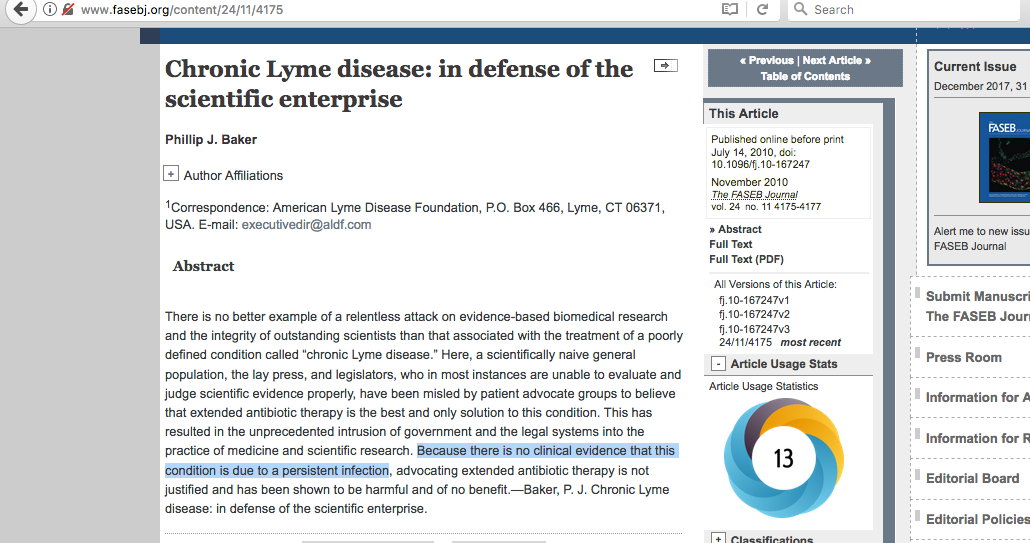|
Crossfit's Most Authoritative Expert Demoted to Bro Science Peddler? I like Kelly Starrett. He was able to spread the word on mobility to a lot of newbies over the past few years. Also thanks to Starrett, Crossfit enjoyed so much more sophistication of technique in its last 5 years. However, his initial insights have given way to hyperbolic overstatements which are being eviscerated by movement experts of all kinds. For those of us who've used different banded variations, corrective strategies and fascia work for 15 years (or more), we've seen his fame rise in kind with laypeople becoming more acquainted with the same concepts. Different body workers have done this stuff for 150 years. But when I first did self-myofascial release in the 90s, I couldn't find anybody who understood what I was doing. Now, it's the opposite: you have a hard time finding people who haven't heard of a foam roller. And we have to thank famous advocates like Starrett for getting the education out there. With all popular trends, there is some good and some bad. It's great that a lot more people are thinking about how their bodies should move, what optimal technique is, and what a movement practice should be. Unfortunately, the downsides are innumerable. Many people having this "enlightenment moment" about mobility are doing far more harm than good. Some don't have sufficient strength or muscle mass, but they are obsessed with breaking down tissue with a lacrosse ball or roller. They get trapped in a nonstop pain cycle which didn't exist prior to knowing the word "fascia". Others, not understanding active control, spend excessive time on passively jamming tissue into positions it isn't prepared to handle. When they experience pain from tissue damage, their "remedy" is to traumatize the tissue more with various stretches and direct pressures. No healing ensues. None of this is singularly the fault of Starrett or the Crossfit organization. Crossfit was one of many attempts to make variable training modalities more popular. As it succeeded in spades, more people than ever began teaching and being taught workouts without sufficient understanding of human movement. Starrett worked to create sanity within that. He worked to reduce the firestorm of orthopedic injuries. He wrote the book (literally) on how to move for various exercises in April of 2013. He did good. The oddity with Starrett's book is that it is devoid of any references for the statements he makes about human movement. Somehow this glaring omission didn't stand out upon my first reading of the book. Largely because I was viewing it as a perspective of recommendation, I found little fault. But there's another perspective which holds it up as the final word on directives or even a reference textbook, which creates a lot of problems off the bat. However, this shouldn't have been a surprise, because Crossfit founder Glassman has had a similar track record of making claims about human movement which find no substantiation in rigorous scientific literature. I don’t need to go into detail here, because Dr. Quinn Henoch (GREAT article with notes here: http://www.jtsstrength.com/articles/2013/11/15/supple-leopard-vs-world/) and a whole litany of others have done blow-by-blow analyses of Starrett’s claims. The simple fact remains that Starrett did not ever provide a dataset for his “torque” claims, force production testing results, references, or EMG tables to substantiate anything; and his panacea claims (which amount to little more than hand-waving blasé anecdote) are even more specious. Again, it’s not to say he’s some evildoer. I like a lot of what he tried to do. And I've found that many clients needed to learn the skill of knee-pry (which, by the by, was being recommended by Pavel and Dan John before Starrett was born). But as Henoch illustrates, there are ZERO world record holders who practice excessive or exclusive knee pry á la Starret and his ilk. And, frankly, watch the slow motion of every top ranked Olympic Weight Lifter in the world. I'm not talking about the top Crossfitters. I'm talking about the people who weigh 50lbs less than the top Crossfitters and lift 100-200 more pounds than them. You won't see ANY excessive knee-pry. None. I was actually shocked to find that just about every rock bottom snatch or clean catch/rock-bottom squat of Olympic competitors has the knees substantially INSIDE the feet. Go ahead. Do a quick search. Henoch also made several valid observations about well-accepted and known realities with some of the oddities and nuances of hip rotator muscles (some internal rotators above 90 degrees become externally rotating below 90 and vice versa). These important pointers are essentially devoid in any of Starrett’s numerous posts, videos, interviews, or the book. We have the additional and more significant problem that certain skeletal differences in the layperson would put a Starrett student in potentially, severely threatening risk. Thus, despite the ostensible thoroughness of Starrett, and despite just how likable he seems, his techniques are certainly not universally true. His penchant for hyperbole has landed him closer to the bro science than science camp. And this has some fairly obvious implications, given that, at least in my opinion, he was one of the more sensible and knowledgeable guys toeing the Crossfit line. Add to that his relative lack of experience (i.e. - most of my colleagues have logged thousands more hours of coaching time), and I’m really just disappointed to see that he’s avoided seriously answering these growing criticisms from well-meaning clinicians, strength coaches, trainers and experts around the globe. Some average blokes doing the exact opposite of Starrett's sermon pictured below: Starrett demonstrating his knee pry belief:
0 Comments
“If I had six hours to chop down a tree, I’d spend the first four sharpening the axe.” – Abraham Lincoln Peter Thiel, the co-founder of PayPal (also billionaire board member for Facebook, venture capitalist and hedge fund creator), confronts allegedly busy people. He asks two questions: 1.) Are you actually working and being effective? 2.) Or are you just creating the impression that you are working hard, merely signaling to others that you are a busy person? He sees the busy professional, business owner, tech startup, executive, or investor as ostentatious but unproductive. It’s a sentiment which Warren Buffett has echoed, and Richard Branson has harped on. Readers may notice this topic is included in nearly every Forbes and Wall Street Journal interview, every book on world class performance, and basically the quotation anthology of any historic figure whose name we recognize. They call it outright laziness. Some call it lazy-busy. Steven Pressfield in the War of Art encouraged the reader to overcome resistance. He talked about the writer’s journey as an illustration for breaking out of inaction and committing to action. Successful and high-achieving people understand this. They have created a certain level of mastery around defeating the resistance of idleness, sloth, and torpor. It’s a great win, since the tendency in life is inaction. However, as in all things in life, there is a spectrum. Just as there is too little action on one end, there is too much on the other. Ambivalence toward effectiveness, let alone efficiency, is found in both. Sadly, people can and do execute action without purpose, without heart, without intention. Uninspiring busyness can be confusedly equated with productivity. Business meetings and even work can be conflated with motivational impact. Tim Ferriss, the bestselling author and now-prolific interviewer of the most important entrepreneurs and businesspeople of our time, is even less forgiving in his assessment. He calls being busy “a perverse badge of honor" (https://www.cnbc.com/2016/08/25/tim-ferriss-being-perpetually-busy-is-a-kind-of-laziness.html). His argument is simple. If you are perpetually incapable of making time, then you are ineffective, unskilled at time management, and unwilling to develop one of the most fundamental characteristics of leadership: prioritization. Prioritization carries an internal tug-of-war between perception of forthcoming work and your actual capacity to perform that work. Be careful. You are generally telling people that you are too busy swinging a blunt axe to spend the time to get a sharp one. Tasks are going to pile up regardless; so you might as well sharpen the axe which is doing the chopping. Prioritize what creates in you the ability to handle tasks. Remember what enables you to do work in the first place: fitness. I don’t mean in the physical sense of simply being able to do some push-ups. I mean in the universal sense of sound mind, sound body. I mean in regards to the definition, “the capacity to do.” Fitness is blade sharpness. Being so busy that you say you can’t make time for fitness makes for a legitimate-sounding excuse. The only problem is there is no evidence that productivity or effectiveness rises with subtraction of fitness. Fitness (and health), by definition, is the capacity to perform more work in less time, endure more stress with less consequence, and continue to do both with greater sustainability. It is the most important part of the sharp axe. The avoidance, therefore, of investing in ones health and fitness is perhaps more than the underlying lazy-busyness. Perhaps it’s a symbol of that individual’s unwillingness to work hard or smart. There are statistics on this: the Journal of Labor published results showing that workers who exercise earn 9% more than their sedentary counterparts (http://business.time.com/2012/06/08/one-more-reason-to-hit-the-gym-youll-make-more-money/). I’ve worked with many founders, CXOs, advanced professionals, salespeople, and business owners who get stuck. They hit a freeze point wherein they simply aren’t growing as a person anymore. The axe is blunted entirely. Every single one of them, when confronted with this accusation, doubles down on their busyness narrative by invoking “prioritization.” They genuinely believe that they are prioritizing when they’re just being lazy. They believe that swinging a rounded mallet at a sequoia is the responsible thing to do. Sometimes, in this state of defensive bewilderment, they’ve “re-prioritized” such that they’re with family less, contributing to the community less, ultimately spending less time on creativity and restoration. In almost every case, their own health and fitness isn’t even bookended; it’s forgotten. At this point, the busy person has grown to consider the act of sharpening some irresponsible luxury. And those aren’t coincidences. The lack of priority to health and fitness is the cause of stagnancy. It’s not to say people can’t achieve quite a bit during a long period of extremely unhealthy behaviors. Some people thrive in dysfunction for a while, in fact. After all, they are gaining strength to use a chipped-up axe blade while the edge gets duller. Eventually, however, the plateau comes. Bluntness outweighs force. Long-term flourishing growth can only happen when people prioritize a cultivation of foundation. It can only come when there is a regular maintenance of axe blade. Every list of billionaire habits includes exercise and meditative or reading time. Clearly, total development as a person cannot be relegated to a title, a business brag, or a paycheck. It is found in the ongoing development of the total person, both mind and body. We’ve all known someone who carries the threadbare wooden handle leftover from a once-ominous hatchet. We’ve all run into at least a few examples of people who used to “have it.” They used to get things done. They used to be an inspiration. They used to have drive. They used to make a difference. They used to swing a sharpened axe. They used to sharpen it daily, first, before they did anything else. Now, with an inflated title, it’s hard to even explain what exactly they do. They themselves even have a hard time with it at dinner parties. Someone asks them what they do; and they proceed to describe their title, their industry, their background, their rise to their current rank. But when they’re prodded on with what exactly they fill their over-busied week, there’s a lot of “um”s, “reports,” “meetings,” and not much else. They have grown to swing a really blunt handle that once was a portentous, calamitous slicing machine. It’s a sad remnant of a bygone era; and it’s embarrassing. We’ve all fallen into the busyness trap before, since it’s such a fixture in our culture. We think wearing down the blade is accolade-worthy. We invert the Lincoln quote, telling people we need eight hours to perform what should be a two-hour endeavor because we supposedly haven’t the “extra” time it takes to sharpen our tools in the first place. It’s not just a form of laziness. It is laziness. We refuse to put the work in to analyze precisely, prioritize correctly, and execute efficiently. Even though it’s busyness, it is so very obviously more parts lazy than busy. People sense they need to sharpen the axe. We read a Lincoln quote, and we’re indicted and convicted. But where to begin? We can acknowledge the truth of our lazy-busyness and still be uncertain how to change. The whole ordeal seems overwhelming. But nobody said we need to return to a PERFECT sharpness. We must merely assuage the dysfunction little by little. Return to fundamentals: eliminate exhaustion; sleep; move; manage stress; restore yourself; build strength; develop endurance. Then, swing the axe. When the blade dulls, repeat. Next time, before the blade dulls, repeat. Next time, long before any sign of dulling, repeat. A return to fundamentals is not too time-consuming. We know by virtue of the Pareto principle that a small increase in the appropriate input will reap incredible improvement in the effective output. More specifically, very tiny investments of time can yield shockingly beneficial sharpness. Research confirms it: http://www.elev8wellness.com/wellblog_best_nutrition_training_coaching_experts/spend-less-time-on-fitness-in-order-to-improve-fitness-and-everything-else We must confront lazy-busyness in search of effective, productive efficiency. It may cost twenty minutes on the front end of a day. But it’ll save hours on the back end of the same day. It may cost days on the front end of a month. But it’ll save months on the back end of a year. It’s easy to get right to chopping. But it’s a mature step to sharpen. It sounds good to show off your busyness. But all that matters is to showcase your handiwork. It’s popular to claim diligent effort. But it’s rare to demonstrate finished products. When you return to regular sharpening, the Peter Thiels of the world will ask, “where are the hewn trees?” And you will stand over felled groves, with pristine blades at the ready for more. According to recent research funded by the NIH itself, Lyme disease is never necessarily cured by any duration of antibiotic treatment: http://news.tulane.edu/pr/study-finds-lyme-bacteria-can-survive-after-antibiotic-treatment-months-after-infection This is an incredible admission, because the scholarly consensus has been (and is still) that chronic Lyme or persistent infection is pseudoscience or quackery. Search any voice of authority in American medicine or disease research, and you'll only find the term "no evidence" with regard to persistent infection. The overwhelmingly popular response from medical doctors (including infectious disease specialists) and disease researchers is that chronic Lyme is not a real thing. According to them, it's a fiction made up by delusional people and reinforced by questionable outlier practitioners and quacks. In a little head-fake, these same authorities created a moniker to weasel their way out of reality: Post-Treatment Lyme Disease Syndrome. Basically, it's their way of saying, "yes, everyone still suffers the same or worse symptoms of Lyme after antibiotics; but that is no indication that infection persists, because infection cannot persist, because we said so." This contemporary news story is of particular interest, because it is up against an entrenched belief system and paradigm. We'll have to see how this unfolds, because the various authoritative research bodies have been the ones who've long gotten this wrong and are still championing what amounts to pseudoscience themselves. It may be an odd turn of events for some readers; but the skeptics of chronic Lyme are actually the toe-the-line Luddites. Previous research has already confirmed for us many times that the bacteria of Lyme disease is a very different creature than all other known bacteria and it persists: - In mice after antibiotics: http://www.ncbi.nlm.nih.gov/pubmed/24466286 - In humans after antibiotics: http://www.ncbi.nlm.nih.gov/pubmed/23929025 - In mice following antibiotic treatment: http://www.ncbi.nlm.nih.gov/pubmed/18316520 - Borrelia persists in cystic and atypical forms in response to hostile environments: http://www.ncbi.nlm.nih.gov/pubmed/23929025 - Borrelia converts to spheroplast in spinal fluid: http://www.ncbi.nlm.nih.gov/pubmed/9646104 - Borrelia spirochetes convert to cystic form within 1 minute in uninhabitable environment: http://www.ncbi.nlm.nih.gov/pubmed/10052721 - Borrelia persists in macaques after antibiotic treatment: http://www.plosone.org/article/info%3Adoi%2F10.1371%2Fjournal.pone.0029914 - Biofilm formation of borrelia is understood: http://www.plosone.org/article/info%3Adoi%2F10.1371%2Fjournal.pone.0048277 - Antibiotics ineffective at eliminating round body and biofilm formations of borrelia: http://www.ncbi.nlm.nih.gov/pmc/articles/PMC3132871/ In the recent Tulane research funded by the NIH, every single claim of chronic Lyme sufferers (which has categorically been dismissed in the past) was substantiated: - 90% of infected individuals DID NOT showcase the bullseye rash - many clinicians still use the presence of the rash as a positive-for-infection diagnostic tool. - Some subjects who were confirmed as infected with Lyme tested negative on typical antibody titer tests your doctor would administer. Most clinicians regard a negative titer test as definitive that the patient has no infection. - Months after a 28 day (far less than most clinicians are willing to prescribe for) administration of the caustic doxycycline, the drill-shaped bacteria were still viable and burrowed into the bladder, heart, brain and skeletal muscle. The general problem with the chronic Lyme debate has been that the medical world long ago embraced Lyme disease tests which by their very nature cannot work for Lyme. These faulty tests (which are genuinely considered the gold standard despite no evidence we can reliable trust them) measure the presence of the patient's antibodies against the borrelia bacterium. However, the Lyme is immunosuppressive. Therefore, this test could only work in the rare case that the patient were taking antibiotics before the test long enough to counter the suppressive effects of the disease. But even then, it has severe limits with accuracy.
Consequently, other researchers, suspecting that the vast majority of the scientists and medical experts are dead wrong, utilized microscopy to just scan for the presence of the bacterium specifically: http://www.apollon.uio.no/english/articles/2013/2_borrelia.html. Though their results were a deafening, definitive, and resounding "YES!," the antiquated official position continues to be parroted. The old paradigm has proven difficult to kill despite overwhelming evidence against the scholarly consensus. Some scientific consensus has little to do with science and more to do with holding the popular view of peers. The debate over chronic Lyme is yet another example of this. But just maybe, now that the NIH itself was involved in this research AND that it is recent, the scholars can finally join the "quacks" who were right all along. A locking knee is a painful experience. Typical search queries will only return results for meniscus tears and their surgical interventions. Many clinicians' input will result in the same. However, my experience is that most "clunking" and painful knee locking is specific tibia-fibular instability which can be retrained.
I show here one version of the affliction which Lyme Disease and antibiotics fomented. However, I also show how you can immediately correct it. The longterm cure is a process whereby you continue improving the skill of moving the joint through its entire range of motion (and with lateral and dynamic pressures eventually in the future) without any snapping or painful locking. Some clients with whom I've worked have a similar condition, but with the fibula. Palpating and experimenting with internal rotating and sliding pressures can resolve this as well. The ultimate goal is to recreate deep squats and sideward movements under load without the snapping, and folded crossed-leg positioning without lock, which most people would consider fully healed. One can anchor bands or some other tether behind the body and around the front top aspect of the shin while performing squats, deadlifts, messier squats, hip thrusts, until this can be achieved with less and less assistance. It may look like you don't. It may look like, even if you do, it's too complex for your decision making to play a role. But your decision making does play a significant role.
Science confirms it: http://citeseerx.ist.psu.edu/viewdoc/download?doi=10.1.1.690.8118&rep=rep1&type=pdf Read more here: For years I've heard people try to quantify what percent of fitness success can be attributed to either "working out" or "nutrition." Is it 50/50? Is it 80/20? Is it 90/10? My answer: wrong question. Mindset is Everything. And your mind goes where it will. Your identity, actions, words and even genetics will follow. The sets of instructions in your body are only as powerful as which ones are turned on and activated. Think of DNA like a field of nuclear weapon silos. Their presence only represents potential. Unless you choose to fire them, you aren't in a state of overt nuclear war: https://www.whatisepigenetics.com/what-is-epigenetics/ I've written about this before. Here - Genes Don't Make You Fat And here - Genes Don't Make You Who You Are And how to change anything. The reason I even bring up this topic again is because it sits smack dab in the middle of all internal debates over change. People want to change. Or they think they do anyway. And I see the struggle every single day, including this very hour I write this post: Today I had appointments from 5am to 3pm with no breaks. When I was wrapping up my first appointment of the morning, I noticed my 6am was not here (and it was nearly 10 minutes after). I checked my phone to find that she and her husband (my 8am client) both cancelled because of the "dangerous" cold. "Odd," I thought, since it was warmer today than when they were here on Monday. I was outside both days at the same time, and it was at least 5 degrees colder Monday. I looked up the weather and found that there had been predicted some wind gusts which could create wind chill; but I just stood outside (in between writing these two sentences) without a jacket with my sleeves rolled up for 10 minutes and it's dead, no wind, not unbearable (and later that day I and my son, who was 3 at the time, were wholly unaffected playing outside for a while). Windchill does not matter if you're covered up anyway. Since I was reading the text aloud, my 5am client as she was packing up to leave rhetorically queried/opined, "are they young children who have to sit at a bus stop for 45 minutes waiting for a bus that may not arrive because it's broken down while their parents have had to go off to work already?" I laughed. But then... I just felt sad. I love them like family. They are awesome people. Out of all the clients I have today, they are the only ones not showing up. They are not the oldest. They have the most reliable transportation of all. They live closer than any other appointments. Their cars are in a garage. I know. Sometimes people have other things going on, and they feel it's polite to blame circumstances. But I fear it's deeper. And not to offend anyone, but you can either think like a lean person or you can think like a fat person. Tony Robbins (yes, I like Tony; don't judge me) calls this "modeling." If you want to be a certain way, you have to think like THAT person. Yes, this can start to get complicated with phobias and addictions. In this case, sometimes action will have to precede belief. If you act like someone who doesn't have a phobia or addiction long enough, you become it. You think it. Then you become it. Then you do it naturally. That is, once you choose a course of action or a goal, you must commit wholeheartedly, which in turn will change the genetic imprinting. If you say that you want to lose 80lbs, every decision must be couched in the question, "what do people who actually lose 80lbs do?" Do they punk out of a workout because it's too hot? Do they back down from a session because it's too cold? Do they eat crap in the face of stress, holidays, peer pressure? No. They choose to change their DNA. Placentophagy, or the eating-of-placenta, has enjoyed a pop culture surge in recent years. Thanks goes largely to celebrities who are famous for being famous for popularizing it. Other holistically-minded individuals hopped on board with the best of intentions. However, it's an ancient practice which never gained a ton of popularity among intelligent mammals (i.e. - humans) even in antiquity because it didn't demonstrate any reliable benefit. Modern researchers took the celebrities' claimed health-benefits seriously. They worked tirelessly to show what benefit there is, if any. To date, no dice. We're left with two shockers: 1.) famous entertainers aren't the fount of scientific and health expertise; 2.) respectable researchers are having to waste their time and our dollars countering what amounts to fad bro science.
Recent studies have failed to show any evidence of benefit for placentophagy: https://www.alphagalileo.org/ViewItem.aspx?ItemId=179838&CultureCode=en And so far, the only thing we know for sure, is consuming it is dangerous. The placenta is not inherently sterile, nor (even if it were) would it remain sterile via the birthing/after-birthing process. There are documented cases of infection from placentophagy; and so the CDC, late to the party as always, has finally begun to issue warnings against it. A slightly more sophisticated reader may parry, "well, that's why you cook it and/or freeze dry it in capsules." Unfortunately, that does nothing to toxins and the cell waste leftovers from dead bacteria (which is why you can still get severe food poisoning from thoroughly-cooked food). There is no overabundance of nutrients in the postpartum placenta. Lab testing, however, does find lots of heavy metals in it. This is no surprise, since it serves as a filtration system for the fetus. Thus, like all filters, it will carry within it the very items we were preventing from entering the body. Imagine someone taking the oil filter out of her car and jamming it into the gas tank. Really, it's practically the same thing. Just because the oil filter is an important part of getting oil safely into moving parts does not make it an appropriate fuel source. Just because the placenta is an important part of getting fetus-specific nourishment safely into the fetus does not make it appropriate for anything else. Now, in theory, it stands to reason that there would be some hormones within the placenta which may exert some benefit for the person consuming it. This is the last bastion of hope for placentophagy advocates. And, I admit, it sounds modestly reasonable. However, even if the infection and heavy metal exposure risks were somehow overcome, would the tiny remnant of hormones provide benefit? The answer is a hard no. This may come as a surprise to people who thought placentophagy was a new idea; but researchers in 1980 found in rat studies that the effect was THE OPPOSITE: https://www.ncbi.nlm.nih.gov/pubmed/7431335. Changes were nonexistent or detrimental, because, like the consumption of any exogenous hormone (like synthetic testosterone, birth control and other steroids), whatever trace amounts of hormone in the placenta are just enough to interrupt ones own natural endogenous production of the appropriate hormone balance. Human studies are no more promising: https://www.ncbi.nlm.nih.gov/pubmed/28859955. There are a few people who, even when confronted with the reality that there is no benefit to placentophagy, still swear that they really experienced something positive. Maybe they did. The common placebo effect is the first explanation. The unscientific nature of anecdote compared against no control group is another. It's easy to believe you benefitted from an act you predetermined was good for you. Also, now that we know they likely suffered heavy metal poisoning and endocrine disruption, we can add temporary acute (or ongoing) lapse in mental and emotional faculty as a third possible explanation. This isn't an insult. Even small amounts of toxicity and exogenous hormones alter a person's brain and perception, sometimes permanently. Of course, we can't discount the basic desire of people simply wanting a natural remedy for various postpartum ailments. I do. We all do. It would be great if there were a wonder drug, and that it happened to arrive divinely-delivered from the birthing experience itself. For some pre-scientific people, the placenta made sense as this magical cure. For modern people who can actually test, monitor, and manage nutrient, hormone and neurotransmitter levels, however, placentophagy is nonsense even if it did work. But it doesn't. For people concerned about optimal health for mother and baby, there exist inexpensive tests to determine how high or low you are on just about any nutrient, hormone or neurotransmitter; and there exist inexpensive foods and supplements which can address those highs and low. There exist convenient and tasty foods which can genuinely accomplish even the most wildly-claimed (but unsubstantiated) alleged effects of placenta. Additionally, these actually-proven and effective foods and supplements won't give you heavy metal poisoning or your newborn baby a life-threatening infection. Test your blood for iron and eat some lentils or spinach. Test your neurotransmitter balance and eat some eggs and drink spring water. Test your steroidal hormones; wait; retest to see if they regularize and eat some healthy fats. It’s true that many other mammals practice placentophagy. They also eat feces, their babies, vomit, rotted corpses, and each other; and they lack critical thinking, writing and reading skills. Interestingly, camels and sea-dwelling mammals do not eat their placenta. It may be hard to believe, but the vast majority of humanity got it right, and hyenas got it wrong. Less surprisingly, dolphins know better than Kim Kardashian. We don’t need to rethink our proper intuition that placentophagy was wrong in the first place. Published in the Lancet, another body of research shows us that type 2 diabetes is entirely reversible with lifestyle alteration: https://www.alphagalileo.org/ViewItem.aspx?ItemId=181550&CultureCode=en. The accompanying health issues related to diabetes are arguably the biggest ticket items in American health care costs at the macro level. So, it might be a good idea to begin paying attention to studies like this.
There is this prevailing belief in popular culture and even among some wise health and fitness experts that certain health challenges are black or white afflictions. However, everything is on a grey scale. We are either moving toward one end or the other. Type 2 diabetes, being a perfect illustration, is not something which you either have or don't. We are moving toward or away. The conventional layperson understanding of type 2 diabetes is as follows: once someone has crossed an arbitrary point of delineation, she is diagnosed as diabetic; and with this diagnosis comes drug interventions. From that point of view, drugs are the savior to help one live with this affliction. Some clinicians reinforce this idea. Unfortunately, that point of view is unscientific. Insulin resistance and glucose tolerance are ever-fluctuating states which change every hour of every day with everyone. Thankfully, within the scientific and medical communities, there are teams committed to pointing out this self-evident axiom. It's a sort of oddity, really, since we already have a fairly good understanding of how physiology works with regards to this particular grey scale. But every few weeks or months now, another body of research comes to beat this dead horse in an overkill effort to remind people that type 2 diabetes is entirely reversible. I feel like I just wrote about this two weeks ago: http://www.elev8wellness.com/wellblog_best_nutrition_training_coaching_experts/clinical-results-in-the-reversal-of-diabetes. |
Elev8 Wellness
|
LIVE. AWESOME.We offer the highest quality in personal fitness, nutrition, and mindset coaching, helping you achieve your fitness, health, wellness and performance goals no matter the obstacle. With virtual online training and private, in-studio training we make it easier to reach your wellness goals safely.
No more can't. No more not good enough. If you compete in a sport, let your mind no longer hold you back from being the greatest. If you don't, let your mind no longer hold you back from being the best version of you that you can be. Sign-up for a Tour Covid Screen Waiver Elev8 Waiver Become an Elev8 Instructor Space Rental |
6244 lyndale ave. s., minneapolis, mn 55423
|
© 2021 Elev8 Wellness LLC. All Rights Reserved. site map | contribute | SITE BY Sproute Creative



















 RSS Feed
RSS Feed
